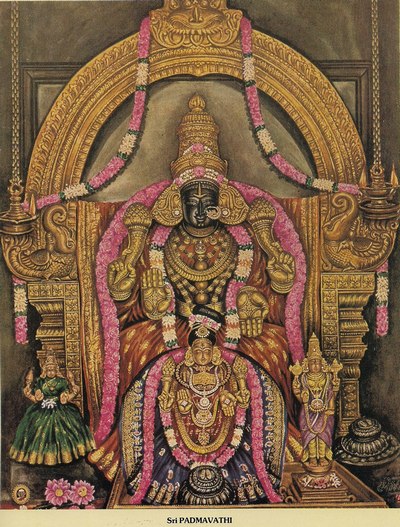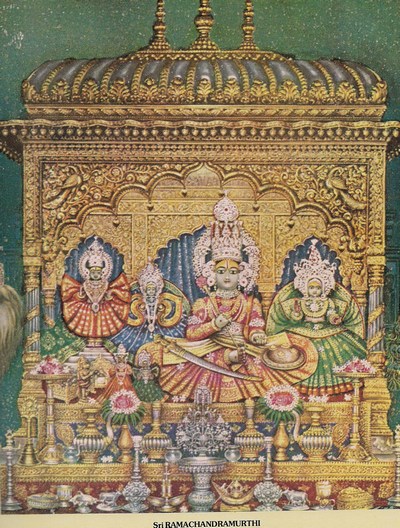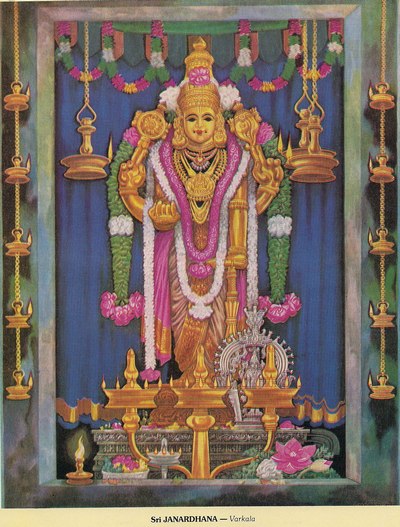VAISHNAVAM
The cult devoted to the worship of Vishnu, and his ten incarnation specially Sri Rama and Sri Krishna is Vaishnavam.
The great saints Ramanuja and Chaitanya and many Vaishnavite seers gave a convincing boost to the spread of Vaishnavam throughout Bharat. And the two incarnations Sri Rama and Sri Krishna have been instrumental for the wide spread practice of Vaishnavism.
Vishnu is married to Laxmi, who gives him the power of love and care.
Sri RANGANATHA(Srirangam-Tamil Nadu)
 The temple of Sri Ranganatha is situated at Srirangam on an island strip, between the sacred Kaveri river and its largest branch, the Kollidam. The temple is foremost among the 108 Divya-Desas sacred to Sri Vaishnavites and one of the greatest in the South, known as Boologa Vaikuntam. Historically this is four thousand years old. This temple has seven prakaras some of the outer ones being regular streets with residential houses. In this temple, sri Mahavishnu known as Ranganatha is in a reclining pose, on the serpent couch, Adisesha, awe, inspiring in size
The Sthalapurana has it that the Lord was worshipped by Vibishana, brother of Ravana.
According to Valmiki’s Ramayana, the idol of Ranganatha at Srirangam was the one worshipped by the predecessors of sri Rama of the Ikshwaku dynasty of Ayodhya. Srirangam is a centre of pilgrimage all round the year. All the 12 Alwars (realized souls) in their ecstatic darshan of the Lord have rendered Pasurams in praise of the Lord.
The ‘Arayar Seva’ the exposition of Divya Prabandam(Tamil Vedas), through Nritya is a remarkable item forming part of the festival of Lord Ranganatha. Vaishnava Acharya Sri Ramanuja adorned the pontifical seat at Srirangam and spent nearly twenty years and wrote his monumental works.
HIMALAYAN ABODE OF THE GODS- The Holy Badrinath
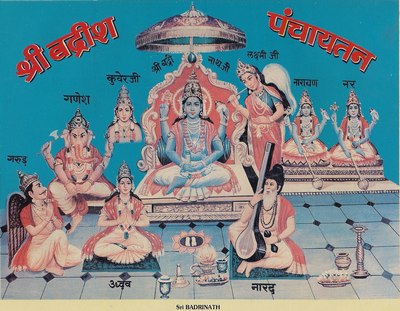 In the scriptures, it is said that our departed ancestors have always believed and have ever been praying with a profound faith that an illustrious descendent of theirs will come to Badri Vishal and offer Pindas to them at the Brahma Kapala and then they will be liberated and attain Moksha.
Beliefs and rituals apart, at least for the serene beauty of the Himalayas and the alpine atmosphere, a trip to Badrinath is a rewarding experience and a pilgrimage will definitely lift everyone spiritually, mentally and physically.
The holy shrine on the banks of the Alakananda and the valley town flanked by the two mountains Nara and Narayana has the added attraction of the Nilakantha peak, ever bound in snow and called the queen of the Himalayas, peeping at the temple giving a glimpse of the Himalayas glory and beauty.
With 10,300 feet for an altitude, the Badri Vishal comes alive in the month of May when pilgrims throng the town. In November, the entire population migrates to Joshimath, along with the God, when the temple is closed for winter.
The temple was originally erected and sri Badrinarayan installed by Adi Sankara but avalanches have washed away the temple many a time and the temple as it stands today is 45 feet in height with shining kalasam on the top.
In the Sanctorum Lord Narayana is seated in the Padmasana pose. The shaligram is black but the skillful Rawal priest decorates the idol to present a Viswaroopa. On his left are Nara, Narayana and on the right are Ganesh, Kubera and Garuda. In front are the images of Narada and Uddhava.
Mention should be made that the Badri temple is devoted to vishnu and it is one eye of the Himalayan ranges, Kedarnath devoted to siva being the second eye.
The sanctity of the temples, the religious rites, all in the traditional Vedic styles are strictly performed since ages by the Namboodiries of Kerala now called Rawals.
Sri JAGANNATH (Puri �Orissa)
 The temple of Lord Jagannath is located the city of Puri in Orissa on the sea coast. The ancient nature of this temple is borne out by its mention in the Rig Vedas. Structurally it is unusual and beautiful, being 214 feet tall with a metallic wheel of perimeter 36 feet fixed on its peak.
The unique feature of this temple is that the important deities worshipped here are Lord Jagannath,his brother Lord Balarama and his sister Devi Subhadra. The daily pooja in the temple start with the waking up of the deities, placing them in front of a huge mirror and sprinkling their image with scented water and offering of food items seven times a day covering a varieties of 56 items.
Every year in the month of June, the deities are taken for a boat ride, bathed with 107 pots of sacred water and subsequently are offered carefully chosen food items. The Rath Yatra of Lord Jagannath is known world-wide. The Rath(Chariot) itself is 60 feet high and has 16 wheels. Millions of devotees throng to witness this festival.
The idols have a unique appearance with big eyes, a wide mouth and wooden sticks to support the hands and the feet. Legend has it that while one king named Indradhyumnan tried to usurp the idol of Lord Jagannath from the devotee Viswavasu, it disappeared and the king was instructed to use the log that he would find floating in the sea to make the idols. An old man offered to make these, with the condition that none should open the room for 21 days. But the impatient king had the room opened after 15 days on hearing no sound emanating from the room. The idols were found in the room in an unfinished condition.
The idols are placed on a pedestal of 20 feet height. The temple is both divine and beautiful.
DWARAKA
 Dwaraka, the abode of Lord Krishna is mentioned in every scripture known to the Hindu-Mahabharata, Harivamsa, Vayu puranam and Bhagvatam. Research scholars identify the present Dwaraka with the original capital of Krishna. Some dispute it, as some puranas indicate that the prosperous Dwaraka was inundated by the sea.
Dwaraka is in Saurashtra near Okha port and famous for the temple of dwarakadish, popularly known as Ranchodrai. The temple on the banks of the river Gomati has a beautiful Sikar, seven storeyed and 140 feet high. The mandapa has five storeys with a dome supported by 64 pillars. Extensive and delicate carvings adom the precincts.
Five rituals called Go-Karas are prescribed for the devotee (a) A bath in the river Gomati(b) Intake of Go-maya(C) Godana, the gift of a cow(d) Gopi Chandana application of the white earth(e) Darshan-of the Gopinath-Krishna, all connected with the holy cows and the gopis.
Adi Sankara established the Dwaraka Peet (Mutt) and installed Sri.Sureshwara (Mandana Misra prior to his conversion) as the Peetadhipadhi-And the tradition continues to this day.
Dwaraka has been visited and glorified by the great seers like(Ramanuja Madhwacharya and innumerable religious saints like Jnaneshvar, Vallabacharya, Govindswami of Bengal, Chaitanya Prabhu and Meerabai.
Sri VENKATESWARA(Tirupathi- Andhra Pradesh)
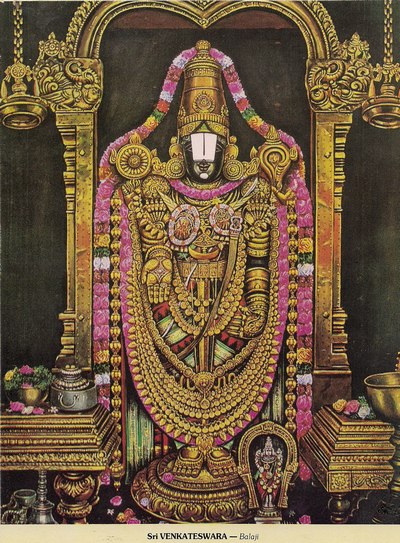 Situated in Chitoor district, as a branch railway line connected to Renigunta on the main Bombay-Madras line, also accessible by air and bus from all parts of South India. Tirupathi is one of the Swayamuyaktha Kshetras(place hallowed by the descent of cosmic power(God) on earth), where the devout worshipper is believed to experience the effect of prayer.
The temple is on the top of seven hills, and is one of the 108 places of worship sacred to the Vaishnavites. The richest temple in India, visited by the maximum number of devotees from all over India, the presiding deity is known as Venkateshwara, Venkatachalapathi and Srinivasa in the south, and Balaji in the north.
The poorest of the poor and the rich, pour their offerings in the Hundial there, as a mark of sacrifice and perform Anga Pradakshina a special form of Praying with folded hands, all parts of the body in touch with the ground, the body itself rolling on the inner Prakaram of the temple housing the deity, a sign of total Physical surrender. Darshan is available to the devotees throughout the day except for a short break.
For over 2000 years this temple has been devotionally patronized by all the ruling families of South India, the Pallavas, Cholas, Pandians, Vijayanagar rulers, Nayakis, Reddies and others. One of the greatest devotee of the Lord was Krishnadevaraya, the Vijayanagar emperor. He endowed the deity with invaluable jewels, treasures, lands etc. A metal portrait of the king and queen can still be seen inside the temples in addition of the deity. Vaishnavite Alwars -6th-9th century, have poured forth soul-stirring hymns on Lord Venkateswara. Annamacharya, the noted composer has several thousand songs in praise of the Lord. These songs were engraved on copper plates and have survived to this day. The saint composer Thyagaraja has sung in praise of Lord. Arunagirinathar has sung Tiruppugaz in praise of Lord Venkateswara.
Sri PADMAVATHI(Tiruchanur-Andhra-Pradesh)
Three miles from Tirupathi town in Andhra Pradesh, is Tiruchanur, where the temple of Alarmelu Mangai is situated. She is the consort of Lord Venkatachalapathi. She is also known as Padmavathi Thayar, as she is believed to have been born out of a lotus flower. There is a legend, that soon after the marriage, the Lord and his consort fell out, because of a feud that ensued between them. The spirit of the legend is even today preserved in the form of pooja prevalent in the Shrines. While Vaikhanasa form of worship is done for Venkateswara, on the hills, the Pancharatra is observed for his consort at the foot of the hills.
Sri VARADARAJASWAMY(Kanchipuram-Tamil Nadu)
 The temple is situated in Vishnu Kanchi, also known as the Little Kanchipuram. The Moolasthana is on a little hillock called Hasthagiri.
Once Brahma is said to have performed a very big Yagna, and during the time of Poornahuthi all the Gods and Devas were present there, when Lord Mahavishnu appeared out of the Yagna Kund. They requested him to stay there for ever to bless the devotees. He readily acceded to their wish and made Hastagiri his abode. He was hailed as the King of boon-givers, Varadaraja. He resides in Punyakotivimanam by the side of Ananda Pushkarani-the Holy tank.
Ramanuja, the exponent of the Visishtadvaitha philosophy of the Hindu Religion, had his education here.
The great work of Krishna Deva Raya, the Vijayanagar King, for the temple, the services rendered by Lakshmikumar Tatacharya, which is continued today by the Tatacharya family, the Shrine of Perundevi Thayar, the paintings of the 108 Vaishnavite Divya Desas and the exquisite beauty of the 100 pillared mandapam, attract the attention of pilgrims. It is recorded that King Achyuta Raya of the Vijayanagar dynasty, was weighed against gold (Tulabaram) which was utilized for a grant of houses for the
Vedic Pandits who rendered services to the Lord of Hasthagiri.
One of the important temples which is included in the itinerary of pilgrims and tourists throughout the country. Gardua Sevai-Procession of the Lord mounted on Garudavahana- is a very popular and colourful festival in this temple during the Tamil month of Vaikasi (May-June)
In the temple tank, an idol of Varadaraja, made out of a fig wood (Atthivaradhan) lies immersed. Once in 40 years, the murthi is taken out and kept on display for 10 days for devotees to have darshan . Special Pujas are performed during these 10 days
Sri RAMACHANDRAMURTHI(Ayodhya-Uttar Pradesh)
Ayodhya of Ramayana fame, the holy birthplace of Sri Rama is in Faizabad district of Uttar Pradesh, on the banks of the river Sarayu. It is one of the seven Mokshapuris.
There are many temples and places of worship in Ayodhya, besides the importance connected with the life of Sri Rama. The ancient idol of Sri Ramachandramurthi and Sita Devi and Lakshmana have been preserved intact inspite of historical conflicts and are worshipped by millions of devotees of Sri Rama. There are a number of Maths around this place, belonging to Ramanuja and Ramanandiya schools of Vaishnava Sampradaya. Sri Rama Navami-the birthday of Sri Rama is the main festival at Ayodhya, which is a noted pilgrim centre for Hindus.
Sri SITARAMACHANDRA(Bhadrachalam-Andhra Pradesh)
It is believed that Bhadra, son of Maha Meru did penance for many years in the Dhandakaranya forest, on the banks of the river Godavari. Lord Ramachandra gave darsan to him and in recognition of his devotion fulfilled his wish and made this place His permanent abode with sita and Lakshmana, to bless devotees who resort to His worship.
This temple, according to tradition was built by a great Rama Bhakta-Ramadas, a thasildar, with Government money. He was imprisoned by the Nawab,for building this temple by appropriation of Government funds, and was kept in a solitary cell in Golconda Fort. Sri Rama came in human form and got him released by paying the money due to the state.
It is one of the important Rama temples of India, situated in Andhra Pradesh. The main deity “Sri Ramachandra” has four hands with
Sanku, Chakra, Bow and Arrow. Sita is seated on Rama’s lap and Lakshmana is seen standing a distance away.
Sri JANARDHANA (Varkala- Kerala)
Varkala is a small town in Kerala, north of Trivandrum.
The Prajapathis, were cursed by Brahma to be born as human beings, for an offence commited by them. They had to undergo the consequent sufferings to regain their original status after worshipping Lord Narayana. Brahma therefore consecrated Lord Narayana here as Janardhana along with Sridevi and Bhudevi. This place was chosen by Sage Narada, by throwing his Vatkalam (bark garment) and the place where it fell is known as Varkala.
The temple is situated on raised ground adjoining the seashore. This is the only major shrine dedicated to Mahavishnu as Janardhana.
Sri KRISHNA(Guruvayur-Kerala)
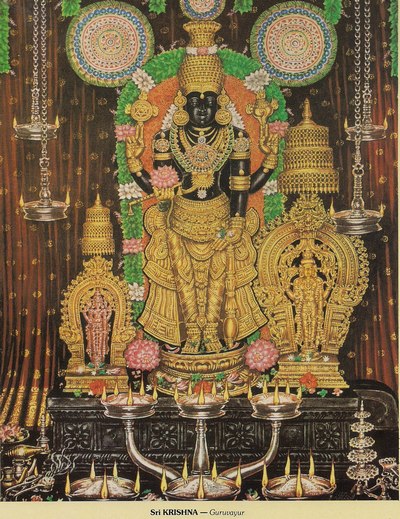 Guruvayur is situated in Kerala, 30 Kms, from Trichur town.
As per the Sthalapurana, a beautiful little idol of Lord Vishnu, and kept for personal worship by Sri Krishna at Dwaraka. Just before the deluge of Dwapara Yuga when Dwaraka was about to be submerged by the ocean, it was brought here by Guru and Vayu, the celestial preceptor and the God of wind-in deference to the wishes of Sri Krishna.
The ever smiling Guruvayurappan showers his benign blessings on the hundreds and thousands of devotees who throng the temple everyday seeking His grace. Devotees around this region revere this deity as their Kuladevata.
The noteworthy features of the daily routine are(1) Recitation of Gita Govindam in the temple(2) Seeveli Procession and (3) a dance form Krishna Attam, performed as offering to the deity during nights.
According to tradition Melpathur Narayana Battadri,a scholar and poet of great eminence, who lived four centuries ago, dedicated to the lotus feet of the Lord, the inspired Narayaneeyam, verses retelling Bhagavatam in a nutshell in divine presence-and had his rheumatism cured completely.
Sri KRISHNA (Udupi �Karnataka)
 Two Krishna Temples in South India attract a large number of pilgrims. Both are in the West Coast, a region traditionally known as Parasurama Kshetra. One is at Udupi in Karnataka and the other at Guruvayur in Kerala.
Udupi has a long historical background and represent the unique blending of Indian religious and cultural traditions. It is at present the centre of Dwaitha Philosophy of Shri Madhavacarya, the propounder of the Dwaitik School with its emphasis on Bhakti. He was born in 1238 A.D. near Udupi. Shri Madhvacharya, a seer and saint, had the Darshan of Sri Krishna. While meditating on the sea shore of Malpe, he saw a ship sinking and brought it to safety. When the ship-owner offered anything to the swamiji for this help, Sri Madhavacharya wanted nothing but the three maunds of Gopichandra brought from Dwaraka from where the ship started its Jounery. The maunds were kept in the ship for custody. The first maund contained the image of Balarama while the second contained the image of Dwaraka Krishna. Sri Madhvacharya composed twelve sacred hymns on Sri Krishna known as ‘Dwadasa Stotram’. These slokas contained the philosophy of Bhakti cult. Sri Madhvacharya installed the murti at Udupi facing East in the shrine in the 13th Century A.D. After about 400 Years, Kanakadasa, the shepherd saint of Karnataka, appealed to the Lord to give him Darsan through the Western window of the temle, as he was precluded from entering the temple. The Lord was attracted by the pure devotion, the idol turned from east to west to give Darshan to Kanakadasa and from then on is facing West.
Shri Madhvacharya established eight Mutts around the Shri Krishna Temple here, initiated and appointed eight monks to worship Lord Shri Krishna and propogate the bhakti cult. Each monk became the head of a mutt and each of them used to worship Shri Krishna for one and a half month in turn, the rotation being called Paraya. From the time of Shri Vadiraja Swami, the period of worship has been extended to two years Parayam for each Mutt, which is being continued even today. Car festivals including Golden-Car festivals on important occasions, Lakshadeepotsava etc. help devotees to develop their faith and understand the importance of Bhakti cult.
Sri VITTOBA and Mother RUKHMAI(Pandharpur-Maharashtra)
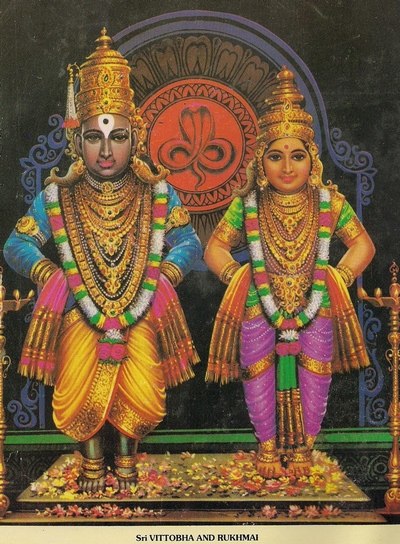 Not even Varanasi, Gaya or Dwaraka can surpass the reverence (created by) Pandharpur. This place is variedly described as the spiritual capital or pilgrimage centre of Maharashtra. The traditional Varkari Pilgrimage, the padasparsha darshan as well as the hundreds of dindis(group procession) and palanquins that visit the temple on evey Ashadhi and Kartiki Ekadasi have given great significance to the town. This holy place has developed along the river Chandrabhaga in the Solapur District.
The temple complex is indeed very old and has been renovated many times. There is evidence to show that a king from Prathisthana of the Shalivahana dynasty renovated Pandharpur in A.D. 83. The deity is also known as Panduranga Vittal or Pandarinatha.
Once Lord Narayana, appeared before Pundarika, having been pleased byhis devoted sense of duty towards his parents, with a view to bless him. But Pundarika who was engrossed in the service of his parents, who did not want to be disturbed even by the Almighty, placed a brick near by, on which the Lord stood and waited for His devotee to turn his attention to Him. In Marathi language, Vit means brick and Uba means to stand. Hence the name Vitoba. In the temple, he is seen standing on the brick pedestal with both his hands placed on his hips. By his side stands his consort Rukmani devi in the picture alongside. Gnana Dev, Namdev, Eknath and Thukaram are some of the prominent devotees who have composed inspired hymns on Vittoba.
There are minor temples like Rukmini temple. The greatest devotee of Vithal, Pundalik as his Samadhi shikhara on the Mahadwar ghat. There are other important structures such as the Trailokya Nam bhavan, and the Tanpure mandapa in Pandharpur.
The Varkari converge on Pandharpur, chanting and dancing all the way, and present an extremely rich and colourful picture. The dance, music and the prayers appeal to all, and the rhythm is captivating.
The fasting days of Sukla Ekadasi(11th day after Moon day) in Ashada and Kritiga months, are important days.
|





